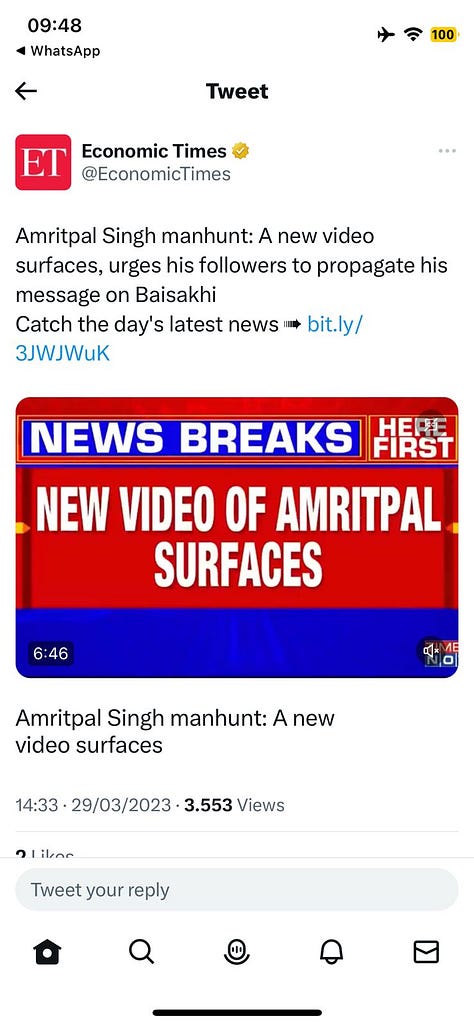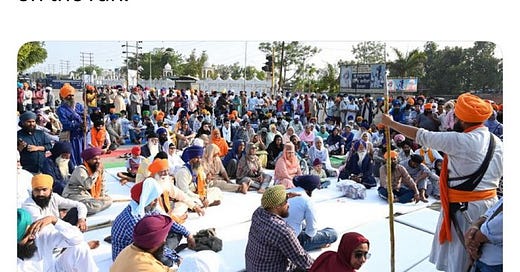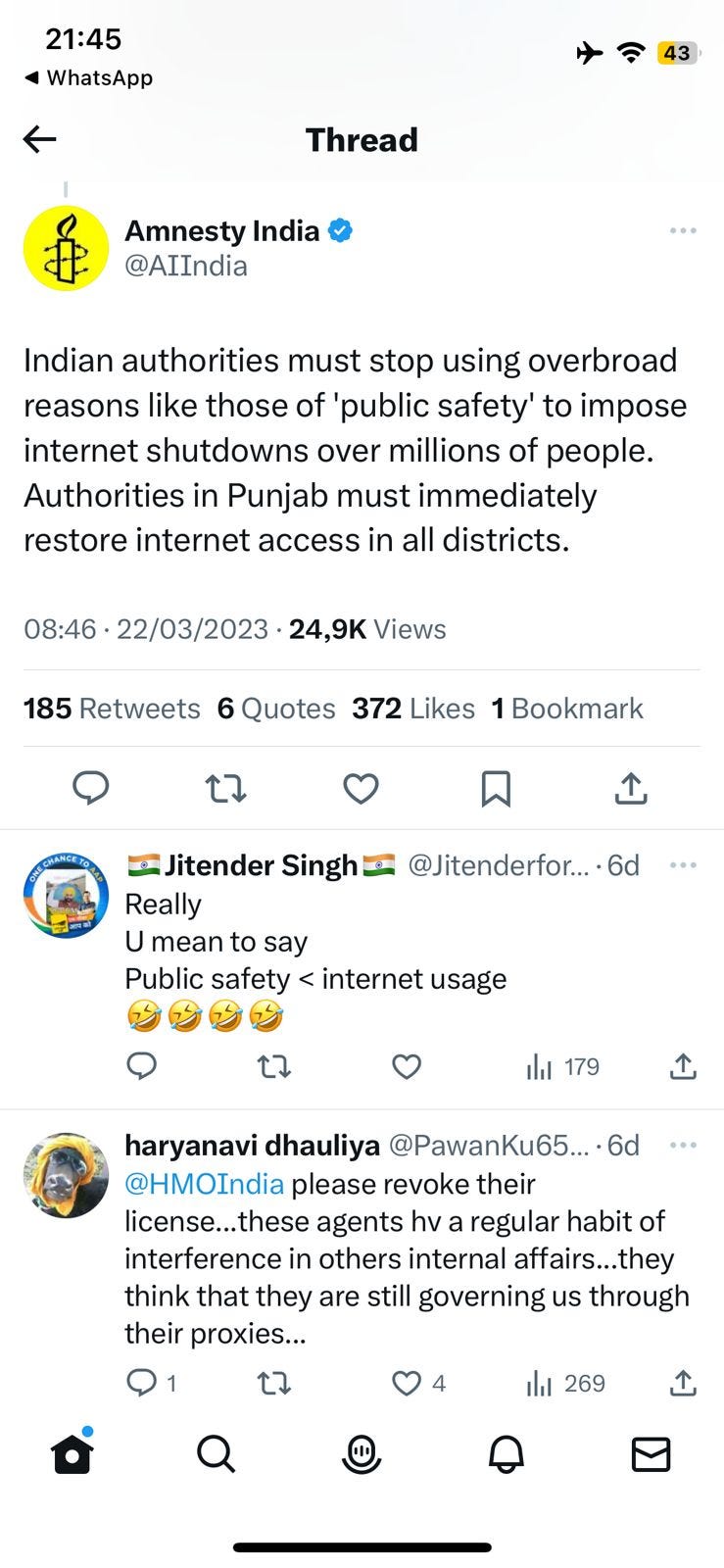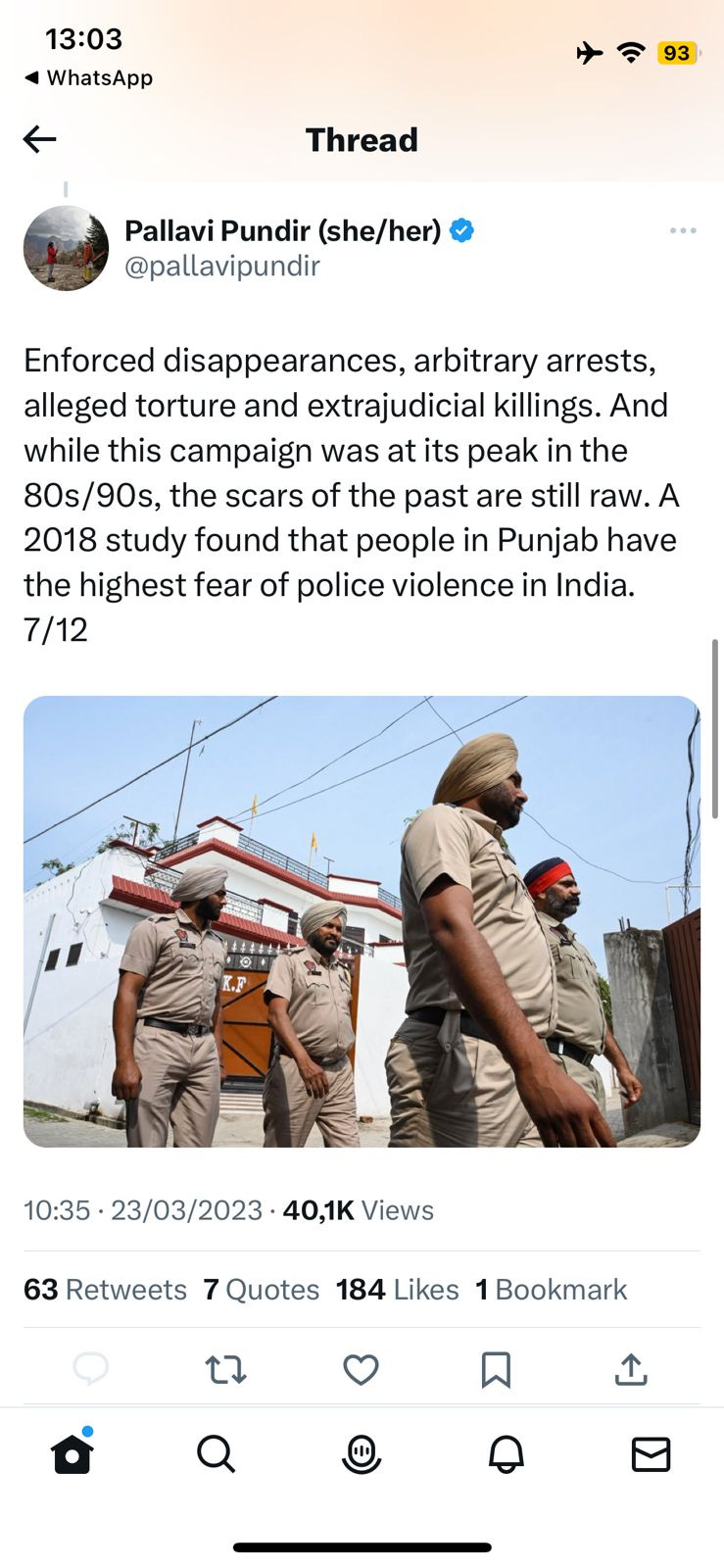From Amnesty to Economic Times, More Transparency Needed on India's Twitter Blocks
Leaving aside the merits of individual censorship requests, both India’s IT ministry and Elon Musk’s Twitter should hold themselves to a higher level of accountability.
Note from Kabir: This is the second in a series of two guest articles by tech journalist Anuj Srivas about the issue of online censorship in India.
The first article in this series explored the strange case of a BBC Twitter handle having been blocked for several hours seemingly at the Indian government’s request.
The second piece here takes a look at how tweets by CNN, Amnesty International, and prominent journalists were also blocked including a tweet that said “Peaceful protest is a human right.”
With the arrest of Sikh separatist leader Amritpal Singh in Moga, Punjab, a chapter in the Indian state’s efforts against Khalistani insurgency has come to a close – even if the story hasn’t ended yet.
With Singh’s capture, and the political atmosphere now being less charged than three weeks ago, this is probably a good time to critically analyse the manner in which the Indian government blocked hundreds of tweets, Twitter accounts and hashtags over the last month or so.
Part 1 of this series examined how the BBC News Punjabi Twittter account was blocked – and then mysteriously restored the same day.
A further analysis of blocking orders sent by Twitter to the Lumen database—a third-party resource managed by Harvard University in the US city of Cambridge, which collects and publishes content removal requests—reveals how a previously unreported set of tweets and accounts have been blocked.
This set of tweets, when viewed together, raise questions over the rationale and effectiveness of the censorship process used by the Indian governement to block offending content under provisions of its information and technology law.
According to an examination of Lumen filings, the following tweets have been withheld from viewing over the last 10 days. These include:
A single news tweet by CNN International’s account
The tweet, as the screenshot above shows, describes a CNN news article on the blocking of Internet access in Punjab.
It’s unclear what objections that officials, either of the Punjab government or of the central Indian government, had with this tweet. One possible explanation is that authorities believe that by not clarifying it was only ‘mobile Internet’ connectivity that had been blocked, the news organization was putting out misinformation.
Nevertheless, leaving aside the merit of the decision to block the tweet, what is puzzling is that the news article that the tweet links to is still accessible and can be read in India. Surely, if the tweet is inflammatory and a danger to public order, the article is as well?
“The article in question appears to be reportage about internet restrictions in the state of Punjab. Normatively, this is a legitimate piece of reporting and should not be a candidate for the content that the executive wants taken down. However, the grounds listed include categories that have been, and will continue to be, interpreted by the state in an overbroad manner,” said Prateek Waghre, Policy Director at the Internet Freedom Foundation, a New Delhi-based digital rights think tank.
“This is speculative, but the decision to issue directions to withhold a tweet, rather than blocking the actual URL/website could be the result of a number of factors. It can reflect the intent to curb/control the flow of information, and perhaps recognising that limiting distribution is sufficient to achieve this goal,” Waghre added.
Four tweets by Amnesty International (one by the parent organisation, and the other three by Amnesty India)
Perhaps the most baffling example of censorship is a tweet put out by Amnesty International, which on March 22, merely said ‘Peaceful protest is a human right’ and repeated it four times. This tweet is currently withheld in India.
Another tweet put out by Amnesty International’s India chapter calls on the Punjab state government to restore Internet access to millions of people. This tweet also has been blocked from viewing in India.
In India, the government has historically blocked content on Twitter through Section 69A of the Information and Technology Act, a fact reflected in the blocking orders uploaded to Lumen. In 2020 though, the Lumen orders stopped specifically mentioning Section 69A, likely due to confidentiality or legal concerns, and started merely stating that the content had been taken down due to the IT Act, 2000.
“While upholding Section 69A in the Shreya Singhal case, the Supreme Court held: ‘under Section 69A blocking can take place only by a reasoned order after complying with several procedural safeguards including a hearing to the originator and intermediary.’ If the originators — Amnesty International, Amnesty India, CNN and other such entities whose tweets have been censored — have not been granted an opportunity to be heard, that would contravene Section 69A,” said Pranesh Prakash, a legal policy researcher.
“On substantive grounds, when it comes to ‘public order’ (as a ground for reasonable restrictions as listed under Article 19(2) and in Section 69), the Supreme Court has relied on two tests: ‘tendency to create immediate public disorder’ and ‘the clear and present danger’ (as reformulated after the Brandenburg case in the USA). None of the tweets [two by Amnesty] you have highlighted would satisfy either of these two tests,” Prakash added.
Three tweets, one each from TV9 executive editor Aditya Raj Kaul, the Economic Times newspaper and TV channel Mirror Now
These three tweets all have one thing in common: they report upon and disseminate parts of a video message issued by Amritpal Singh even as he continued to evade arrest by authorities.



Earlier this month, Singh released two video messages and one audio message even as the manhunt for him continues.
These messages have been widely published, reported upon and written about across the mainstream media. As of April 28, a quick YouTube search shows that many media organisations have videos up that contain excerpts of Singh’s messages.
Now, it is possible that the Centre felt that the reporting by Kaul and two media organisations was inflammatory and contributed to public disorder.
What is less clear is how the exact same content, when published by other media organizations and platforms, is still available online and seemingly had no negative effect on the current situation in Punjab.
A tweet thread comprising 12 tweets published by Vice News journalist Pallavi Pundir
Pundir recently published an article in ‘Vice World News’ along the lines of the CNN news report.
Her tweet thread, which summarizes her article, contains a few statements that provide context to the controversy.
However, it also describes Amritpal Singh as “charismatic” and claims that within the state the separatist leader is viewed as a “hero fighting for rights in a Hindu-majority India”. It is possible that the authorities deemed this to be a problematic characterisation from a law-and-order perspective.
What is puzzling though, as with the case with CNN, is that if Pundir’s tweets had the potential to spread misinformation and cause public disorder, why was the Vice News article itself not taken down? As of March 30, it is still accessible and available for public viewing within India.
A single tweet by a regional account belonging to the Canadian Broadcasting Corporation and a journalist working for the organization. A CBC regional account has also been ‘withheld’ in India.
A tweet put out by the CBC-British Columbia account on March 24 described the experience of a photographer who allegedly travelled with Amritpal Singh in 2022.
The tweet documents the photo-journalists claim that he fears for the safety of his family and friends in Punjab, and also refers to Singh as a “regular guy”; a characterization that likely prompted the Indian government to take action.
There are two takeaways from this particular instance of blocking. Firstly, as with CNN International and Vice News, the article is still accessible in India and can be viewed without any barriers.
Secondly, while there is documentation to show the individual tweet was ordered to be withheld in India, there is nothing to indicate the government wanted the whole CBC-British Columbia Twitter account taken down.
It is possible that there is a separate censorship order for the account itself, and it has not been published on Lumen yet, but as we saw in the case of BBC Punjabi, there is a far more concerning possibility -- that it was taken down by accident.
A tweet by Amneet Singh, the ‘deputy digital director’ for Canadian lawmaker Jagmeet Singh.
Last week, Amneet Singh, whose account and LinkedIn profile say he works for Canadian MP Jagmeet Singh, tweeted out a picture that appears to show members of the Sikh community conducting a protest at Twitter’s headquarters over the censorship of tweets and handles that have addressed the Amritpal Singh controversy.
In his tweet, Amneet Singh also claims that hundreds of tweets/handles have been censored and they belong to journalists, activists and politicians.
As with the case of CBC, Amneet Singh’s account has also been ‘withheld’ for viewing in India, even though so far there has been no specific blocking order asking Twitter to do so.
Broad takeaways
During times of public disorder, or when national security is at risk, it’s natural for authorities to shoot first (or censor first, in this case) and ask questions later. But that doesn’t mean that they are not accountable.
At the level of the blocking process, there are important questions surrounding how Indian authorities choose to censor content:
1) Is there a standard operating procedure for why a tweet or post is blocked, but the underlying content is still allowed to be shared by other people? (As with the case with CNN or Vice News)
2) How does the Indian government justify censoring content put out by certain people, but not the SAME content put out by others? (As with the Amritpal Singh tweets by Kaul, Economic Times or Mirror Now).
3) What is the case for continuing to censor seemingly innocuous tweets like Amnesty’s plea for a right to peaceful protest? Amritpal Singh has been arrested, and the situation is far less chaotic from a security and law-and-order perspective. Why do the tweets remain withheld for viewing in India?
Perhaps the Indian authorities have well-thought-out and nuanced answers to these questions. If they do, they should share them so the censorship process isn’t hijacked by the level of unpredictability and adhocism that many feel it has been.










